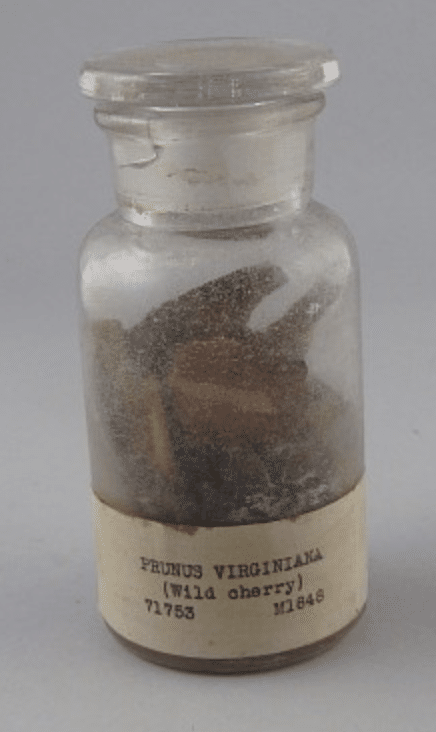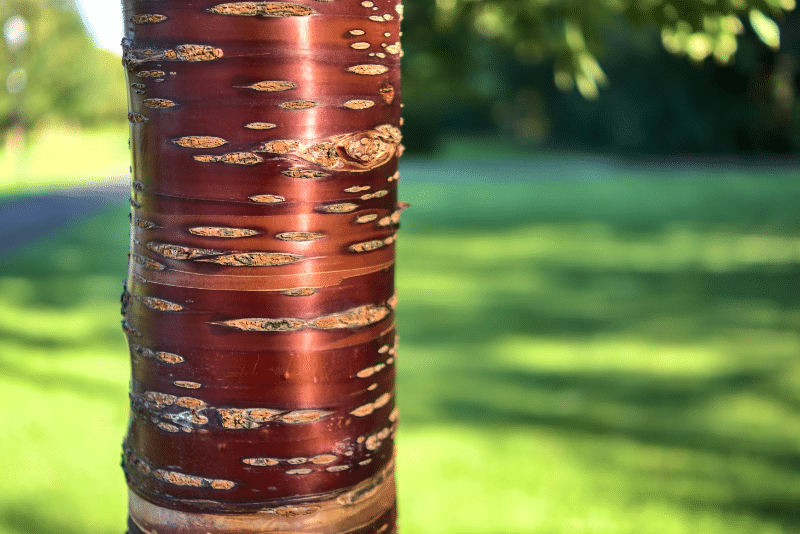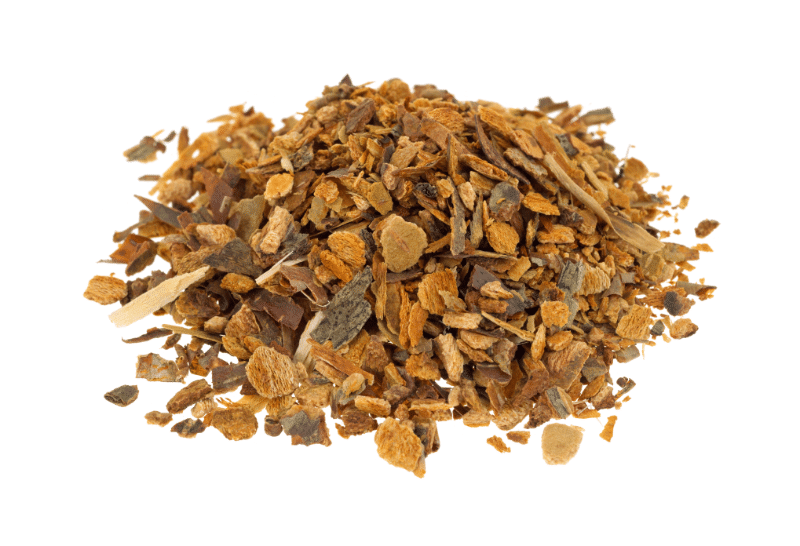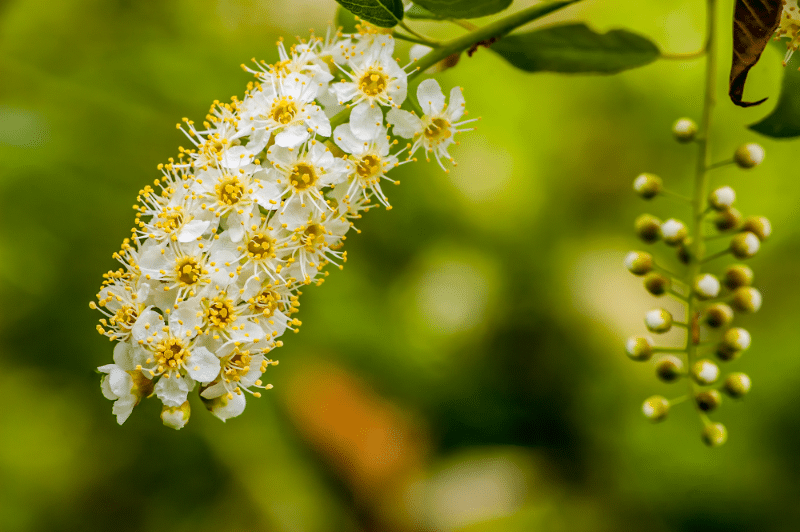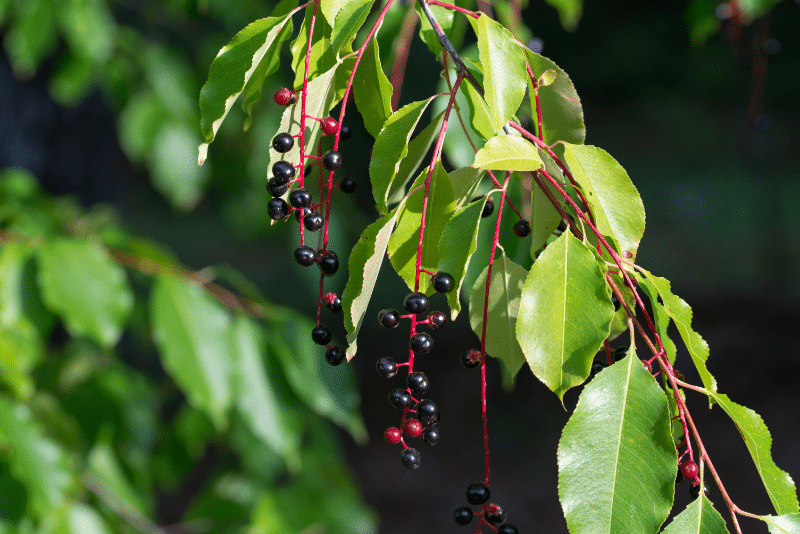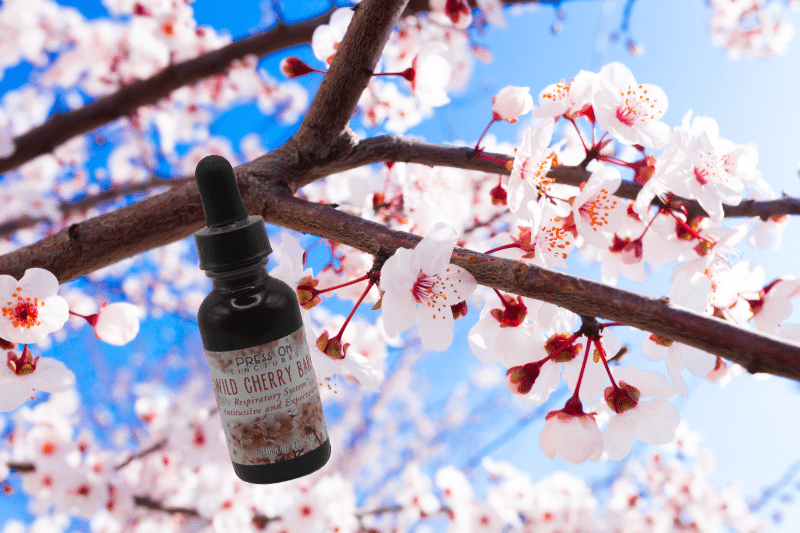Have you ever wondered how to make a wild cherry bark tincture? Not all of us have access to the choke cherry or black cherry tree in our back yards, let alone the time to harvest the bark as would be required. However, for those who do we will guide you through a step by step process so you can aquire your own homeade tincture. The sweet, bitter, and almond like taske of wild cherry bark extracts have long been tied to reports of upper respiratory health and calming affects that sedate both the lungs and digestive tracts. So jump in with us today as we go through all the steps necessary to make a wild cherry bark tincture.
Cherry bark health benefits stem from many years of historical testimonies from herbalists, travelers, and Native American tradition. Before we dive into the mechanics of making wild cherry bark tinctures, lets reveiw some of the benefits of cherry bark.
Health Benefits Overview
As briefly mentioned before, wild cherry has been used historically to relieve or calm the respiratory and digestive tracts. Its main strengths from herbalist’s perspectives have been its ability to act as an expectorant, its astringent qualities, and ability to calm nervous irritability. There are tesimonies of its nutritional support toward fighting various maladies such as pleurisy, pneumonia, whooping cough, and other similar conditions . It has been used for help with diarrhea, gout, and digestive disorders as well. It is used in cough syrups because of its sedative (sleepiness), expectorant (clearing mucus), drying, and cough-suppressing effects. Lastly wild cherry contains chemicals that may help reduce swelling.
Traditional Uses of Wild Cherry Bark

On June 11, 1805, the famous American explorer Meriwether Lewis writes in his journal:
I was taken with such violent pain in the intestines that I was unable to partake of the feast of marrowbones. my pain still increased and towards evening was attended with a high fever. Having brought no medecine with me I resolved to try an experiment with some simples; and the Choke cherry which grew abundanly in the bottom first struck my attention; I directed a parsel of the small twigs to be geathered striped of their leaves, cut into pieces of about 2 Inches in length and boiled in water untill a strong black decoction of an astringent bitter tast was produced; at sunset I took a point [pint] of this decoction and abut an hour after repeated the dose. By 10 in the evening I was entirely releived from pain and in fact every symptom of the disorder forsook me; my fever abated, a gentle perspiration was produced and I had a comfortable and refreshing nights rest.
—Meriwether Lewis
The Eclectic School of Medicine
The Eclectic School of Medicine, developed in the early 1830s, was spurred on by botanical medicine movements and Native American oral traditions in herbs. Those who practiced this discipline found plant based ingredients to support their practices. John Uri Lloyd, a large supplier of botanical drugs for the eclectic physicians, once said that wild cherry was the single most popular medicinal plant in the households of America. See the Smithsonian’s display of one of John Uri Lloyds specimines of “materia medica”, a small sample of wild cherry bark used almost two centuries ago.
The historical uses of wild cherry bark falls into three categories: Tea, syrup, and tincture. When using solvents properly, we can extract the greatest potential out of the bark and receive it in concentrated form. Whatever you use – tincture, syrup or tea – each has their own appropriate place and time where they might be more desirable.
First Ingredient – Wild Cherry Bark
Family
Rosaceae
Common Names:
Virginian prune, black cherry, black choke, choke cherry
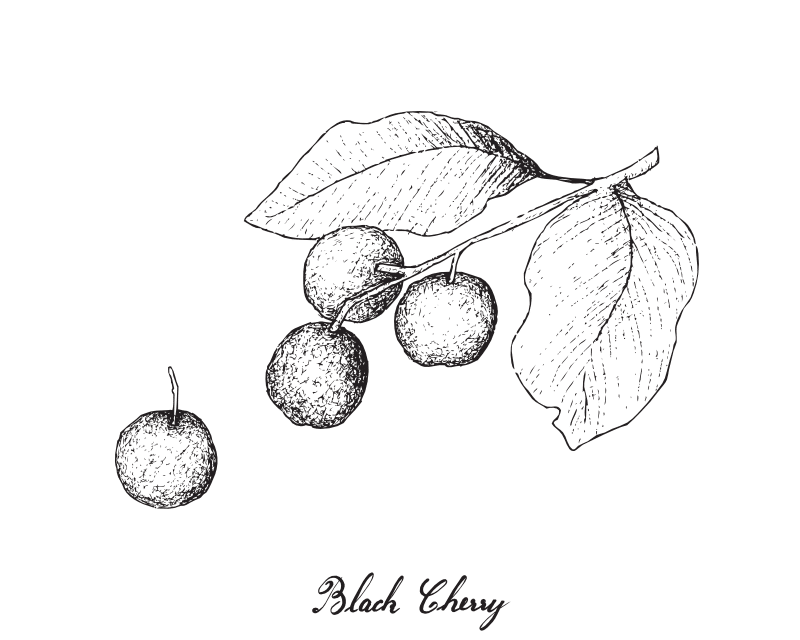
Description:
The Wild Cherry Tree is a deciduous tree that reaches up to 30 feet in height. The leaves alternate, are simple and oblong to nearly oval, 3-4 inches long with pointed tips and a round base. They are dark green on top and a paler green on the bottom. Several flowers, white, appear in a loose terminal raceme.
The fruit is dark red to purple drupe about 4-8mm in length. The twigs are gray, slender, and stout and have grayish dot-like protrusions. The bark is smooth, gray-brown, conspicuous lenticels that develop into shallow fissures; young stems have shallow peeling, curling layers. The roots form an extensive lateral root system where sprouts and suckers readily appear.
Geography of Wild Cherry Bark
Where To Find Wild Cherry Trees:
Wild cherry is found commonly in the United States from southern Maine to Florida, west to Texas and Kansas. It can be found along fence rows and roadsides to dry woods and pastures. Larger trees will be found in woods with rich soil. The plant prefers abundant moist soil with lots of water, space and fertilization. It is propagated by seed.
Parts Used:
Tree bark
How to Harvest Wild Cherry Bark:
Cherry bark comes in different forms: thick bark and thin bark. Thick cherry bark is peeled from the main trunk of the tree. Thick bark is generally brown and ribbed on the outside or dark gray to black and rough. Thin cherry bark is smooth and gray on the outside with hints of red showing through the breaks in the bark as it matures. Thin cherry can be peeled from the trunk of the younger trees before it begins to form thick brown ribs.
In some cases you can find land owners who deem the tree as burdensome, and they are trying to get rid of it. They might allow you to collect all the fresh bark available that otherwise they would waste.
If you have access to a live tree, peel only one side of the tree or branch allowing the tree to heal and continue to grow. Pruning branches from smaller bushy cherry trees also works well for gathering thin bark. Do not collect bark from dead or decaying trees.
Tree bark is best dried indoors although it can be dried in the sun. Drying time will depend on weather conditions. High humidity will slow the drying process. Thick bark will dry slower than thin bark. The more air you can get around each piece of bark the better it will dry. A thin layer of bark will dry much easier than a pile of bark. When cherry bark is dry it will be brittle and snap. Once it is dry, store the bark in paper bags, cardboard or burlap.
Properly dried cherry bark when broken up smells like almonds.
Buy if you can’t dry:
If you are like most people who don’t have time to go and search the woods and ask friends if they have sources of wild cherry bark, you can buy it from reputable sources. We’ve been very impressed with Pacific Botanicals, who sells certified organic wild cherry bark by the pound.
Second Ingredient – 190 Proof Alcohol
Organic or Conventional?
Whatevery you are looking for, whether organic or conventional, you would do well to know where the distiller you are using gets their supply from and how they make it. We prefer certified organic alcohol due to the commercialized nature of alcohol production, and the repurposing of many genetically modified ingredients. We work closely with suppliers to make sure we get the finest orgnanic alcohol for our solvents.
Third Ingredient – distilled water
High quality distilled water is an essential element to a high quality tincture. Consider doing a test on your water to verify the integrity of the manufacturer’s quality. Properly distilled water should have a very low Total Dissolved Solids (TDS), ideally near 0-2 ppm, not high TDS.
Fourth Ingredient – Perhaps Glycerine
Depending on how much and how long you will be using your tincture, you might consider glycerine to extend the shelf life. It also has a tendency to make the blend more palletable if that is important to you.
Various Supplies
Glass Jar and Plastic Lid
Glass jars are a must. Plastic lids are a lesson learned over time. You can use the old fashioned metal jar lids if you want, but if done consistently you will find your metal lid corroding and disappointing you time and time again. The metal corrosion can also compromise your tincture, with flakes falling into it as you wait for the menstrum to brew.
A tincture press
At the end of the process of brewing, you might want a tincture press. This puts pressure on the main ingredients to squeeze out every drop you can. While it might not totally be neceassary for a first time user, over time you will grow to appreciate how much easier the press make the process for you. Besides we all want to Press On to better things! The options are endless depending on what you are looking for. At Press On, we ended up contructing our own to handle larger loads, and we have been thankful for how it helps us keep up with the demmand.
A straining cloth
If you will be straining by hand a simple cheescloth will work. If you will be using a press, they sell inserts sperately that will hold up under the pressure of the plate as it squeezes your menstrum leftovers.
Step-by-Step Instructions to Make Wild Cherry Bark Tincture
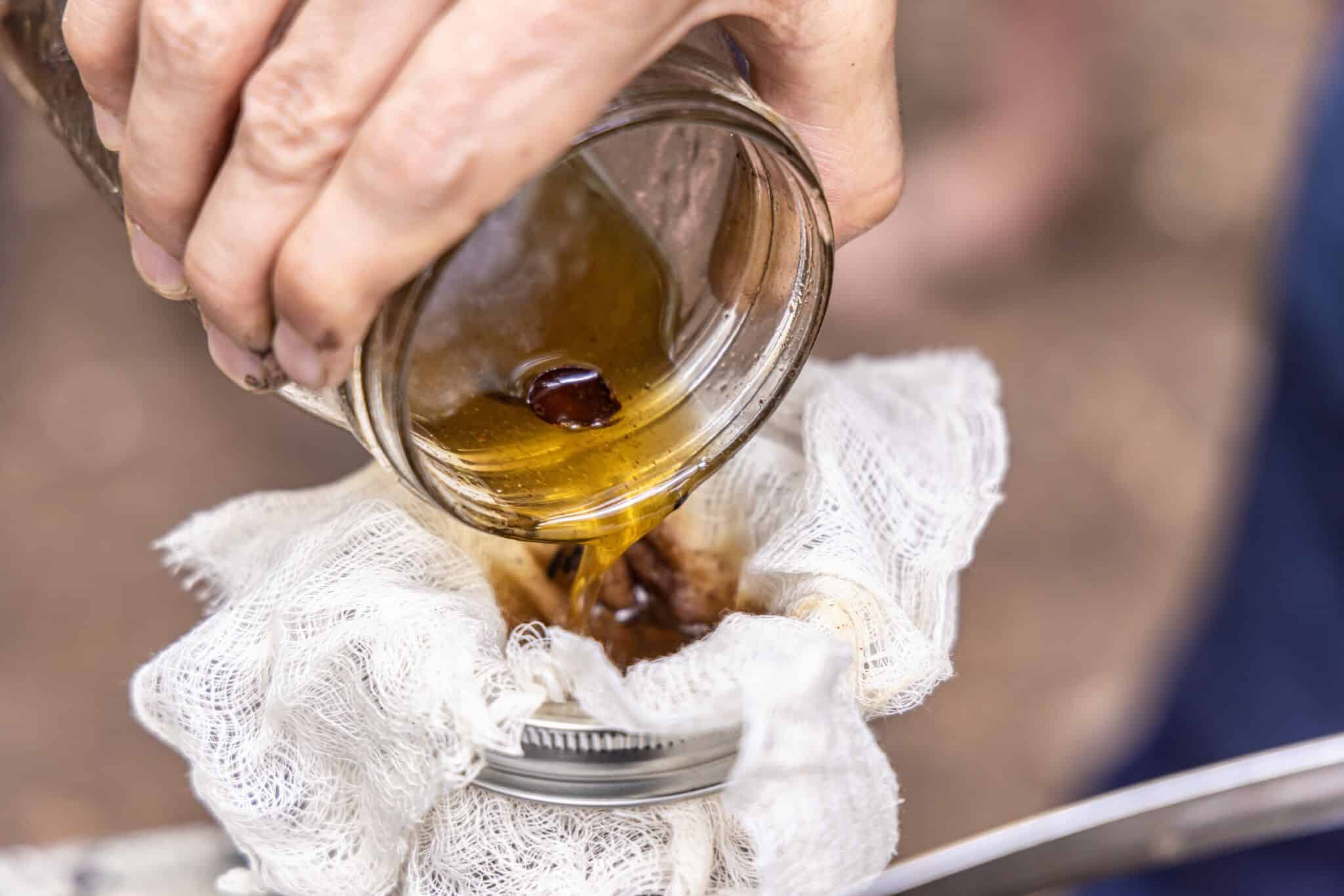
Preparation of Ingredients
Making Wild Cherry Bark tincture without Glycerine
Use One Part Wild Cherry Bark to Five Parts Mesntrum 1:5 (50A:50W)
The proportion of the mentstrum is half water, and half alcohol
So for example:
- 100 grams (g) of Wild Cherry Bark
- 500 milliliters (ml) of mixture of 250 (ml) Alcohol and 250 (ml) Water
Depending on the size you are making, you will have to do some math to make sure it will all fit in your jar.
Making Wild Cherry Bark tincure with Glycerine
Use One Part Wild Cherry Bark to Five Parts Mesntrum 1:5 (50A:40W:10G)
The proportion of the mentstrum is forty percent water, half alcohol, and 10 percent glycerine
So for example:
- 100 grams (g) of Wild Cherry Bark
- 500 milliliters (ml) of mixture of 250 (ml) Alcohol and 200 (ml) Water, and 50 (ml) Glycerine
Tincture Brewing Process
Combine all the associate ingredients in a glass jar, and pour in the distilled water, alcohol, and glycerine. Make sure that the bark is completely submerged and shake periodically over a coarse of two to six weeks. Place the jar to brew in a dark location at a steady room temperature, as sunlight and fluctuating temperatures can diminish the quality of your final product. Steeping too long can make the final product bitter or produce precipitate, but as you get to know the process you will refine the timing. As always and with every tincturing process, the sweet spot is a gift of maximizing extraction through proper ingredients, agitation, temperature control, and proper storage.
Once your brew has fully culminated, you will be able to see the dark red tones of the liquid in the jar. Take the cherry bark tincture jar and pour it over a strainer, catching the strained liquid into another jar or vessel. The goal would be to strain all the bark out of the mestrum, keeping the liquid for future use. All the vital ingredients of wild cherry bark will have transfered to your mixture of alcohol, water, and glycerine.
Find an appropriat dropper bottle to dispense the tincture as you need it and enjoy!
Wild Cherry Tincure Shelf Life
Alcohol-based tinctures can last for years, even decades, when stored properly.
Storage
Storage: Store in a cool, dark place, like a kitchen cupboard, and ideally in amber or blue glass bottles.
Refrigeration
Refrigeration: While not strictly necessary, refrigeration can help to further reduce any minimal degradation.
Storage and Shelf Life of the Tincture
How to Use Wild Cherry Bark Tincture
The appropriate dose of wild cherry depends on several factors such as the user’s age, health, and several other conditions. There is not enough significant scientific information to determine an appropriate range of doses for wild cherry. You could start by taking 1 full dropper in a small amount of water or juice two times a day, and monitor how you see it affects you. Everyone is different and you have to find what works best for you. Read below for the precautions and considerations of cherry bark tincure.
Potential Side Effects *
General Use *
Small amounts wild cherry tincture over a short-term time frame does not seem to exhibit side effects in most people. Taking wild cherry long-term or in large amounts is possibly unsafe.
Those who are pregnant and or nursing *
It’s likely unsafe to use wild cherry. Wild cherry contains a chemical, prunasin, which can cause birth defects. Stay on the safe side and avoid use.
Some medications are changed and broken down by the liver. Wild cherry might decrease how quickly the liver breaks down some medications. Taking wild cherry along with some medications that are broken down by the liver can increase the effects and side effects of some medications. Before taking wild cherry, talk to your healthcare provider if you are taking any medications that are changed by the liver.
Some medications changed by the liver include lovastatin (Mevacor), ketoconazole (Nizoral), itraconazole (Sporanox), fexofenadine (Allegra), triazolam (Halcion), and others.
Consulting Health Professionals
* The collected information on this site is informational in nature, and should not be considered medical advice or council. These statements have not been evaluated by the food and drug administration. The products and information presented by Press On LLC are not intended to diagnose, treat, cure, or prevent any disease.
Conclusion
We are thankful you spent time with us to find out how to make wild cherry bark tincture. If you’ve found the information helpful, please feel free to share it with your friends. We take great effort to provide you with accurate and reliable information. And of course, if you ever lack time to make it, and need some wild cherry bark tincture, we got you covered!
Your friends at Press On!
Masterful Display
Each and everyone of our products are deeply considered, labored over, and improved upon time and time again. We invite you to experience the difference of our carefully crafted small batches of herbal support items. Whether it be our tea line, produced for a delightful experience, or our tincture blends and extracts, we have what you need.



